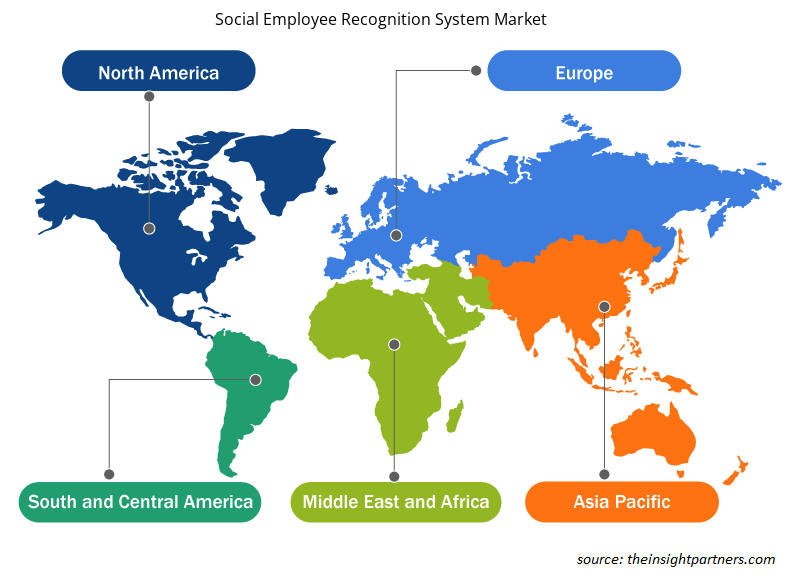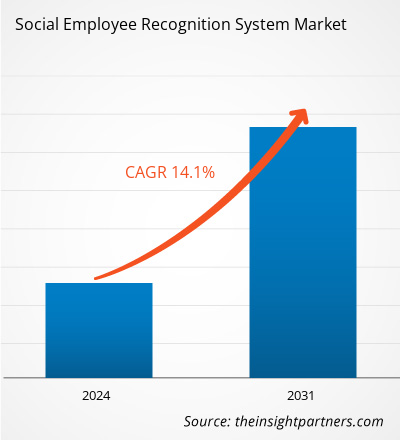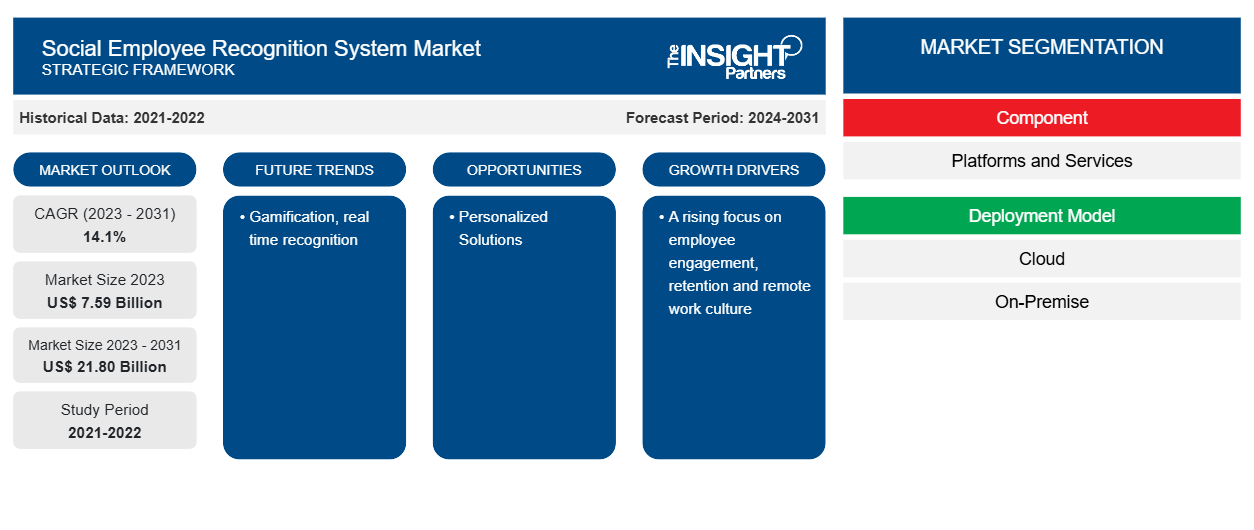Si prevede che la dimensione del mercato del sistema di riconoscimento dei dipendenti social raggiungerà i 21,80 miliardi di dollari entro il 2031, rispetto ai 7,59 miliardi di dollari del 2023. Si prevede che il mercato registrerà un CAGR del 14,1% nel periodo 2023-2031. È probabile che la gamification e il riconoscimento in tempo reale rimangano una tendenza chiave nel mercato.
Analisi di mercato del sistema di riconoscimento dei dipendenti social
Un moderno programma di riconoscimento dei dipendenti è un modo per riconoscere e onorare i contributi dei membri dello staff che sono in linea con le esigenze varie e tecnologicamente esperte della forza lavoro odierna. Utilizza la tecnologia per fornire un riconoscimento rapido, significativo e personalizzato, promuovendo una sana cultura del posto di lavoro e aumentando il coinvolgimento dei dipendenti .
Panoramica del mercato del sistema di riconoscimento dei dipendenti social
Il riconoscimento sociale migliora i legami tra leader, colleghi e dipendenti. L'interazione tra lavoratori senza scrivania, in ufficio e da remoto è resa possibile da esso. Inoltre, le piattaforme di riconoscimento sociale, che sono particolarmente utili nelle grandi organizzazioni, aiutano a smantellare i silos dipartimentali mostrando i risultati di molti dipartimenti. Ad esempio, le aziende con i punteggi di coinvolgimento del personale più elevati hanno avuto una redditività superiore del 21%, valutazioni dei clienti superiori del 10% e un tasso di abbandono inferiore del 24%, secondo un sondaggio Terryberry del 2024.
Personalizza questo report in base alle tue esigenze
Riceverai la personalizzazione gratuita di qualsiasi report, comprese parti di questo report, o analisi a livello nazionale, pacchetto dati Excel, oltre a usufruire di grandi offerte e sconti per start-up e università
- Scopri le principali tendenze di mercato in questo rapporto.Questo campione GRATUITO includerà analisi di dati che spaziano dalle tendenze di mercato alle stime e alle previsioni.
Driver di mercato e opportunità del sistema di riconoscimento dei dipendenti social
Maggiore attenzione al coinvolgimento e alla fidelizzazione dei dipendenti per favorire il mercato
Secondo il sondaggio Haiilo 2024, sul posto di lavoro, il coinvolgimento dei dipendenti aumenta la produttività. I dipendenti coinvolti hanno prestazioni migliori rispetto ai colleghi disimpegnati. I datori di lavoro con un alto livello di coinvolgimento dei dipendenti guadagnano il 21% in più in generale. Uno studio sul coinvolgimento sul posto di lavoro condotto negli Stati Uniti ha rilevato che i lavoratori disimpegnati costano ai loro datori di lavoro tra 450 e 550 miliardi di dollari all'anno. Ciò sta spingendo le aziende ad aumentare la loro attenzione sul coinvolgimento dei dipendenti. Le iniziative di coinvolgimento sociale dei dipendenti contribuiscono notevolmente a consentire la fidelizzazione dei dipendenti.
Soluzioni personalizzate
Per un maggiore successo, le organizzazioni dovrebbero personalizzare i loro programmi di riconoscimento e premi per i dipendenti per soddisfare le esigenze sia del personale che del business. Le aziende possono ottenere un vantaggio competitivo personalizzando il riconoscimento per i dipendenti.
Analisi della segmentazione del rapporto di mercato del sistema di riconoscimento dei dipendenti social
I segmenti chiave che hanno contribuito alla derivazione dell'analisi di mercato del sistema di riconoscimento sociale dei dipendenti sono XX.
- In base al componente, il mercato dei sistemi di riconoscimento dei dipendenti social è suddiviso in piattaforme e servizi. Il segmento delle piattaforme ha detenuto la quota maggiore nel 2023.
- In base al modello di distribuzione, il mercato si divide in cloud e on-premise.
- In base al tipo di premio, il mercato si divide in carte regalo, carte prepagate, viaggi incentive e altri.
- In base al settore, il mercato è suddiviso in commercio al dettaglio, IT e telecomunicazioni, sanità, media e intrattenimento, viaggi e ospitalità , produzione e altri.
Analisi della quota di mercato del sistema di riconoscimento dei dipendenti social per area geografica
L'ambito geografico del rapporto di mercato sui sistemi di riconoscimento dei dipendenti sui social media è suddiviso principalmente in cinque regioni: Nord America, Asia Pacifico, Europa, Medio Oriente e Africa, e Sud e Centro America.
Nel 2023, il Nord America detiene una quota significativa del mercato dei sistemi di riconoscimento dei dipendenti tramite social network. Le organizzazioni nordamericane, in particolare quelle negli Stati Uniti e in Canada, hanno forti tassi di adozione delle tecnologie HR e dei programmi di coinvolgimento dei dipendenti.
Approfondimenti regionali sul mercato del sistema di riconoscimento dei dipendenti social
Le tendenze regionali e i fattori che influenzano il mercato del Social Employee Recognition System durante il periodo di previsione sono stati ampiamente spiegati dagli analisti di Insight Partners. Questa sezione discute anche i segmenti e la geografia del mercato del Social Employee Recognition System in Nord America, Europa, Asia Pacifico, Medio Oriente e Africa e Sud e Centro America.

- Ottieni i dati specifici regionali per il mercato del sistema di riconoscimento dei dipendenti sociali
Ambito del rapporto di mercato sul sistema di riconoscimento dei dipendenti sociali
| Attributo del report | Dettagli |
|---|---|
| Dimensioni del mercato nel 2023 | 7,59 miliardi di dollari USA |
| Dimensioni del mercato entro il 2031 | 21,80 miliardi di dollari USA |
| CAGR globale (2023-2031) | 14,1% |
| Dati storici | 2021-2022 |
| Periodo di previsione | 2024-2031 |
| Segmenti coperti | Per componente
|
| Regioni e Paesi coperti | America del Nord
|
| Leader di mercato e profili aziendali chiave |
|
Densità dei player del mercato del sistema di riconoscimento dei dipendenti sociali: comprendere il suo impatto sulle dinamiche aziendali
Il mercato del Social Employee Recognition System Market sta crescendo rapidamente, spinto dalla crescente domanda degli utenti finali dovuta a fattori quali l'evoluzione delle preferenze dei consumatori, i progressi tecnologici e una maggiore consapevolezza dei vantaggi del prodotto. Con l'aumento della domanda, le aziende stanno ampliando le loro offerte, innovando per soddisfare le esigenze dei consumatori e capitalizzando sulle tendenze emergenti, il che alimenta ulteriormente la crescita del mercato.
La densità degli operatori di mercato si riferisce alla distribuzione di aziende o società che operano in un particolare mercato o settore. Indica quanti concorrenti (operatori di mercato) sono presenti in un dato spazio di mercato in relazione alle sue dimensioni o al valore di mercato totale.
Le principali aziende che operano nel mercato dei sistemi di riconoscimento sociale dei dipendenti sono:
- Soluzioni di Achievers Inc.
- Appreiz Inc
- BI nel mondo
- Globoforce Limited (Workhuman)
- Complimenti Inc.
- Possibili lavori
Disclaimer : le aziende elencate sopra non sono classificate secondo un ordine particolare.

- Ottieni la panoramica dei principali attori del mercato del sistema di riconoscimento dei dipendenti sociali
Notizie di mercato e sviluppi recenti del sistema di riconoscimento dei dipendenti sociali
Il mercato del sistema di riconoscimento dei dipendenti social viene valutato raccogliendo dati qualitativi e quantitativi dopo la ricerca primaria e secondaria, che include importanti pubblicazioni aziendali, dati associativi e database. Di seguito sono elencati alcuni degli sviluppi nel mercato del sistema di riconoscimento dei dipendenti social:
- Achievers ha annunciato l'apertura di una Employee Experience Platform, che fungerà da hub centralizzato per le iniziative relative all'esperienza dei dipendenti. (Fonte: Achievers Solutions Inc, comunicato stampa, settembre 2021)
- Terryberry introduce una piattaforma completa per il coinvolgimento dei dipendenti che include Milestone Awards, Employee Benefits e Recognition. (Fonte: Terryberry, comunicato stampa, marzo 2023)
Copertura e risultati del rapporto di mercato sul sistema di riconoscimento dei dipendenti social
Il rapporto "Dimensioni e previsioni del mercato del sistema di riconoscimento dei dipendenti sociali (2021-2031)" fornisce un'analisi dettagliata del mercato che copre le seguenti aree:
- Dimensioni e previsioni del mercato del sistema di riconoscimento dei dipendenti social a livello globale, regionale e nazionale per tutti i segmenti di mercato chiave coperti dall'ambito
- Tendenze del mercato del sistema di riconoscimento dei dipendenti sociali, nonché dinamiche di mercato come driver, restrizioni e opportunità chiave
- Analisi dettagliata delle cinque forze PEST/Porter e SWOT
- Analisi di mercato del sistema di riconoscimento dei dipendenti social che copre le principali tendenze del mercato, il quadro globale e regionale, i principali attori, le normative e i recenti sviluppi del mercato
- Analisi del panorama industriale e della concorrenza che copre la concentrazione del mercato, l'analisi della mappa di calore, i principali attori e gli sviluppi recenti per il mercato dei sistemi di riconoscimento dei dipendenti sui social media
- Profili aziendali dettagliati
- Analisi storica (2 anni), anno base, previsione (7 anni) con CAGR
- Analisi PEST e SWOT
- Valore/volume delle dimensioni del mercato - Globale, Regionale, Nazionale
- Industria e panorama competitivo
- Set di dati Excel
Report recenti
Testimonianze
Motivo dell'acquisto
- Processo decisionale informato
- Comprensione delle dinamiche di mercato
- Analisi competitiva
- Analisi dei clienti
- Previsioni di mercato
- Mitigazione del rischio
- Pianificazione strategica
- Giustificazione degli investimenti
- Identificazione dei mercati emergenti
- Miglioramento delle strategie di marketing
- Aumento dell'efficienza operativa
- Allineamento alle tendenze normative





















 Ottieni un campione gratuito per - Mercato dei sistemi di riconoscimento sociale dei dipendenti
Ottieni un campione gratuito per - Mercato dei sistemi di riconoscimento sociale dei dipendenti